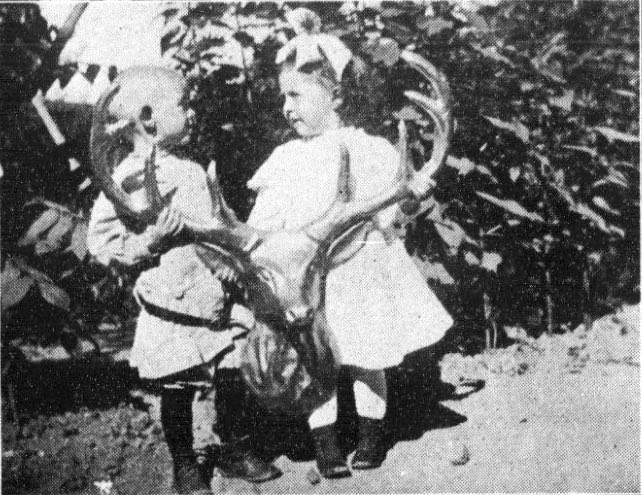
What did women from a hundred years ago grow in their little home gardens? This article, published in 1914, gives a list of the most useful herbs and why it was essential to grow them.

Herbs For Home Garden
Many people in both town and country are no planning home kitchen gardens. In doing so they are sure not to omit the ordinary vegetables, commonly used, but they seldom include the less commonly grown vegetables or the herbs. Yet a supply of these should certainly be provided. For they add variety to the diet and can be produced at much less cost and of better quality than if purchased. On the other hand, while the ordinary vegetables should without doubt occupy most of the space given to the kitchen garden, yet in case of need a part of the family supply can be purchased at the markets or of farmers as a comparatively low cost.
A very small space will be sufficient for an apple supply of herbs for any family and will provide also for gifts to others. Among the herbs, basil, savory, sage, thyme, lavender, chives, horse radish, tarragon and mint will perhaps be wanted by every housewife where conditions make it possible to raise them. Burnet, chervil, coriander, rosemary, fennel, angelica and less common herbs will be wanted by some.
Though herbs have been comparatively little used by American housewives during the past few years, our grandmothers would not have felt they could keep house without a goodly supply. In Europe, herbs have always been much used as seasonings and in France, England and Italy they are now more used than ever before. Even in America their use is again on the increase, due partly to a taste for these seasonings acquired by Americans on trips abroad and partly to the liking for them brought here by immigrants.
Although all herbs are at their best when fresh, part of the flavor being lost when dried, yet they retain much more flavor when dried carefully at home than when dried in the commercial evaporators. Care in culture, picking and drying will do much toward the production of high quality. In gathering herbs for use, care should be taken not to pick too many leaves from a branch at once, or growth will be stopped and the plant will lose its vitality. However, at the end of the season the whole plant is sometimes cut to the ground for drying. The drying should be done at once after cutting to conserve the aroma most successfully. Sage, balm, marjoram, basil, summer savory, chervil and thyme are included among the sweet herbs. In pot roasting meat and baking fish a bundle of such herbs is often used for flavoring.
Marjoram
Marjoram and basil are similar in taste, having a clove-like flavor. Savory, thyme and balm also resemble each other. Sometimes fresh leaves are minced fine and sprinkled over a fish that is to be planked or broiled. Again they are frequently chopped fine and added to eggs for an omelet. Sage is liable to kill the fish flavor, so it should be omitted in this use. A bundle of herbs belongs in every stock pot and, supplemented by a dash of lemon peel, imparts to any good stick the delicious flavor brought out by the French chefs. The greatest cooks in the world realize the value of herbs to such an extent that an herb tray – a deep try divided into various compartments, one for each of six or eight common herbs is constantly beside them.
As a general rule sage should be used with heavy meats, such as pork, sausage, goose and duck. Marjoram, savory and thyme are more delicate and should be used with meats of mild flavor, such as chicken, turkey, partridge and squab. Spearmint or mint has been used since time immemorial with lamb, and is now often used sparingly in fruit salad, combining particularly well with oranges and bananas. Occasionally a sprig is served in iced tea, orangeade or lemonade, when mint ice is a refreshing summer dish.
Several may be termed salad herbs, as they are often combined with salad greens. In this list may be enumerated chervil, parsley, tarragon, burnet and chives. Chervil has a pleasant, pungent taste. Tarragon is well known in vinegar of that name. Burnett tastes like cucumbers. Chives have the flavor of mild onions. A ravigote was the inevitable accompaniment of salad in the eighteenth century, and has recently been revived. It consists of finely minced chives, chervil, tarragon and burnet leaves, piled separately on each serving of lettuce. The name “ravigote” is significant as it means to “pick me up” or strengthen. There is no better natural tonic than these fresh herbs, containing, as they do, great medicinal virtues.
Fennel
Fennel flower, or love-in-a-mist, is grown in nearly every country. The Turks use the seeds in flavoring comfits, the Hindus to keep away moths, while the ladies of Cleopatra’s court used them to produce fastness. Garden fennel is a different herb, the inner stalks being served raw like celery. When this is done they become the famous “Carosella” of Naples. The leaves may be used as a pot herb along with marjoram and sage. The third variety, Florence fennel, has a somewhat delicate flavor like celery. In Italy it is used as a cooked green.
Horse radish is a herb par excellence for beef, a good horse radish sauce being a wonderful stimulant when the vitality is low. In the spring the young leaves make excellent greens and while the roots are at their best in the fall they may be grated and diced, or evaporated and stored in bottles. It must be remembered that in the latter case the horse radish is concentrated and should be soaked for half an hour in weak vinegar or milk to take on its original bulk. In case it is desirable to pickle this herb the grated horse radish may be packed into a wide-mouthed bottle and covered with weak vinegar, seasoned with sugar and salt – a tablespoonful or sugar and a teaspoonful of salt being used to a pint of vinegar.
Chives are particularly delicious in place of onions when a less marked flavor is desirable. Finely chopped and combined with green peppers in sandwiches, minced and sprinkled lightly on fish or steak, as a final fillip to the roast beef gravy, strewn on lettuce or and salad green, mixed with the yolks of stuffed eggs, or added to potato salad, they impart an inimitable flavor.
Rosemary, “for remembrance” is grown largely for sentiment’s sake, although any one raising bees will find that it imparts a delicious flavor to honey. In making conserves, as apple jam or peach marmalade, a leaf or so of rosemary cooked with the fruit will add a wonderful fragrant flavor. Although not like rosemary, rose geranium leaves may be used in the same way, apple or mint jelly frequently having a leaf jellied in the tumbler. A bit of rosemary or rose geranium may be added to an apple pie, or placed in the bottom of a cake and baked with the cake, the steam carrying the flavor throughout the mixture.
Angelica
Angelica belongs to the group of herbs used as sweets. It may be bought candied at any grocer’s or caterer’s but it belongs to the days when women made their own garnishing and understood enough about handicraft to be independent of the caterer. To candy angelica select young stalks, cut them into strips of the desired length, wash well, and boil in water for ten minutes. Drain thoroughly, then immerse in syrup made of equal parts of sugar and water boiled together for ten minutes; simmer gently until it begins to look translucent, about thirty minutes. Then drain, dry somewhat on wire racks, roll in sugar and finish drying in the air.
Coriander is grown for its seed, and is used in the centers of candies, sprinkled sparingly over cookies, sweet rolls or bread, like poppy or caraway seed. Like many of the sweet herbs it forms the basis for a delicious cordial. A wonderful flavor may be imparted to French said dressing if a few seeds are allowed to stand for a few minutes to it.
Lavender is grown for use as sachet. When the flower stalks are at their height of flower they should be cut and dried. The flowers may then be stripped off, stored in tin boxes and kept in a dark place, or in case this is not convenient, the dried leaves and stems may be turned down over the flowers, tied in position and the bundles hung in a dry closet or garret.
In drying place the plants or leaves on racks or papers in a current of air and turn occasionally. A good old fashioned device for drying herbs consists of a wooden frame on which is stretched cheesecloth. The leaves may be placed on this and the free circulation will soon dry them.
After drying, the leaves should be rubbed to a powder, put through a coarse sieve to remove the stems, and stored in airtight tin boxes away from the sunlight. In case it is advisable to dry parsley or tarragon in sprays they may be dried and carefully packed in layers separated by waxed paper. An hour’s soaking in cold water before using will almost restore the original freshness. If any of the dried minced herbs are to be revived to freshness for salad use this may be accomplished by the preliminary soaking.
Oak-fashioned cookery and in fact the best of the modern calls for various herb vinegars. Celery, mustard, burnet, tarragon, coriander, and cress. To make it, pill pint bottles almost full of the aromatic leaves, add a few peppercorns, and cover with moderately strong vinegar. Stand in the sun for two weeks, shaking occasionally, strain through cheesecloth, pressing out all the juice and bottle. Such vinegar usually costs 25 cents a pint. If mustard or coriander is used the bottle should be filled a fourth full of seeds.
Source: The gazette-times. (Heppner, Or.), 15 Oct. 1914.


